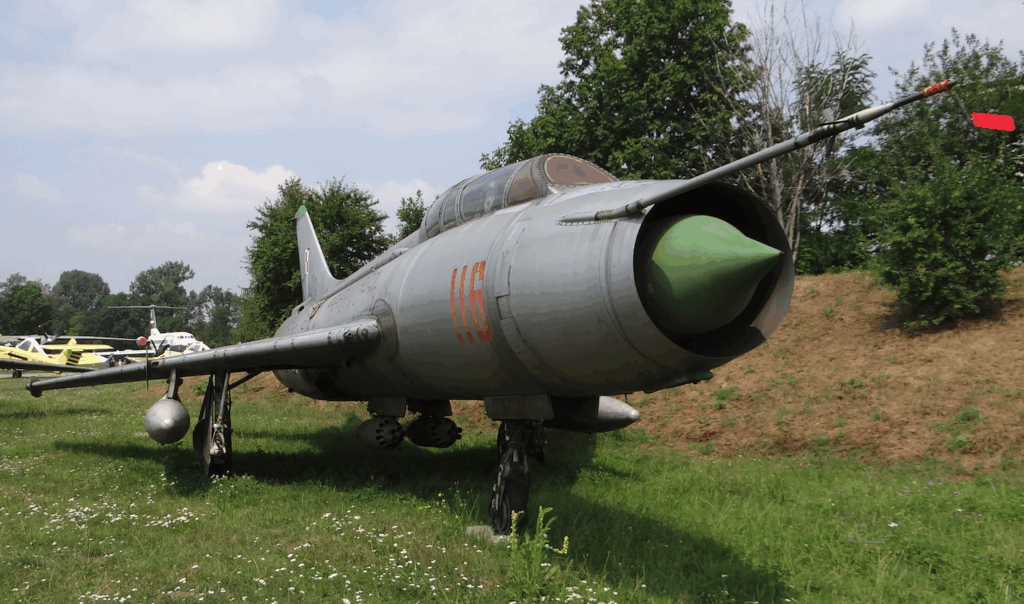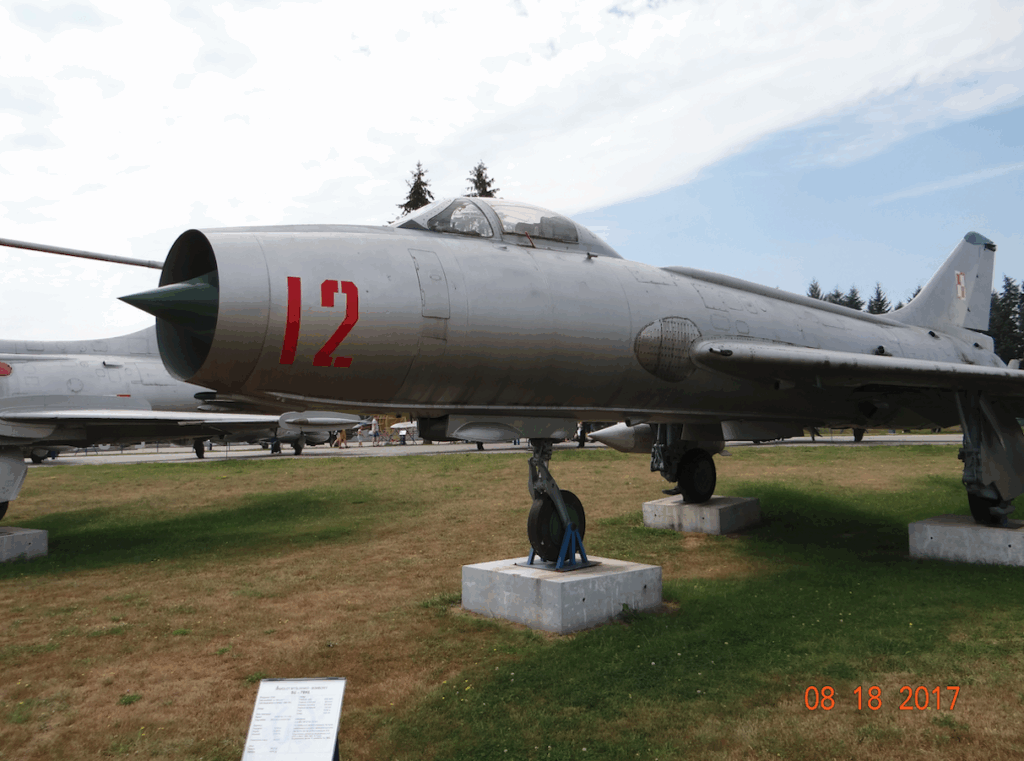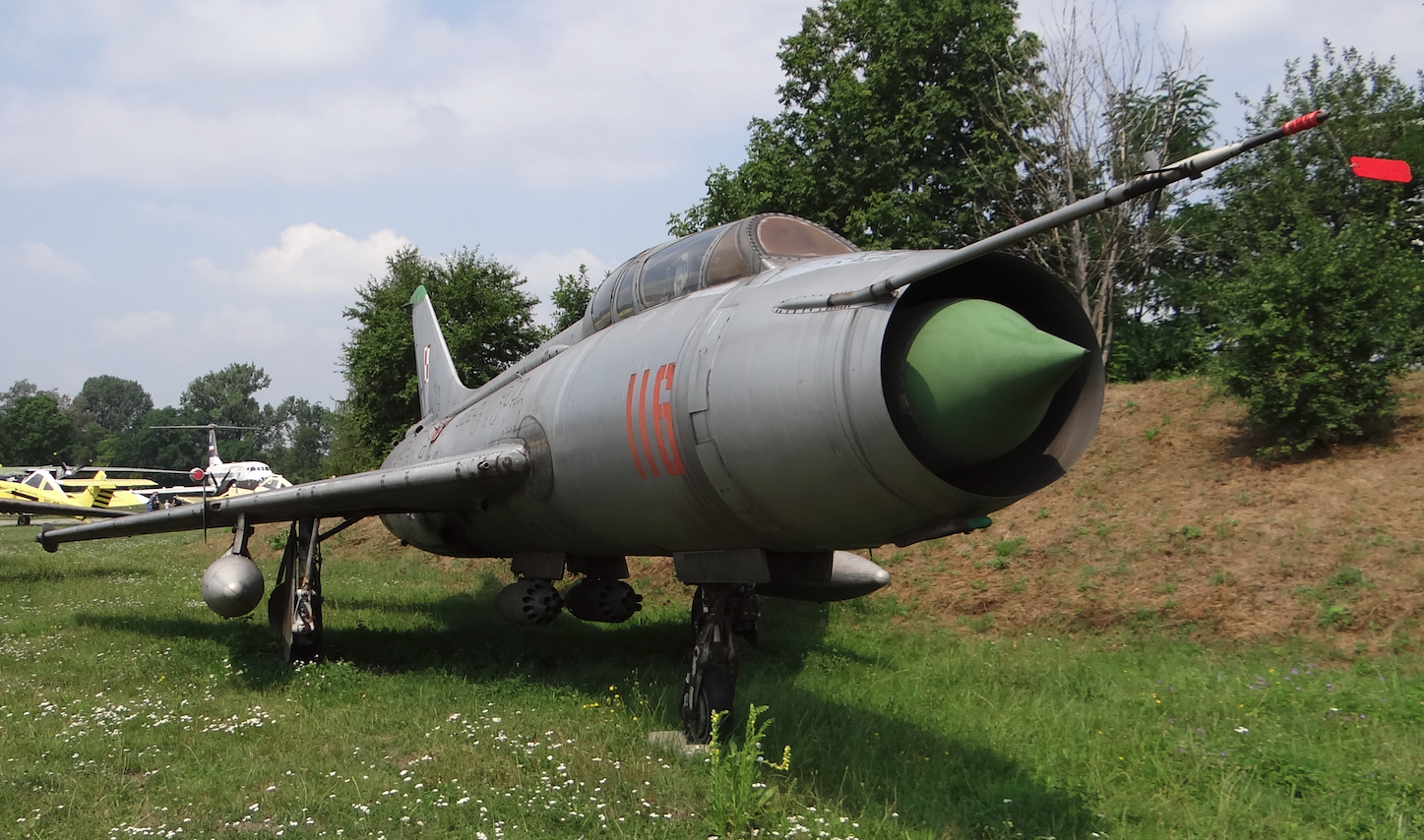Bydgoszcz 2007-11-29
5th Fighter-Assault Aviation Regiment in Bydgoszcz,
and then
3rd Fighter-Bomber Aviation Regiment in Bydgoszcz.
1944-1992


The history of 5th PLM-Sz (3rd PLM-B) dates back to World War II. At the end of August 1944, the 1st Polish Army incorporated the Soviet 611th Assault Aviation Regiment, which was formed according to the post No. 015/282, with a total strength of 199 people. By virtue of the general Order No. 0211 of the Commander of the 1st Polish Army of 28 August 1944, on the inclusion of the arriving units, the regiment was incorporated into its structures. This regiment had a long combat trail behind it and used the already heavily exploited famous Il-2 attack aircraft. Its personnel were one hundred percent Soviet.
On 30 August 1944, the regiment was subordinated to the commander of the 1st Air Division, Colonel Józef Smaga. This was done by virtue of the Order of the Commander of the 1st Polish Army No. 0213 of 30 August 1944, “on the temporary organization of the command of the 1st Air Division”.
On 31 August 1944, the 1st Air Division was renamed the 4th Mixed Air Division, and the 611th Assault Aviation Regiment was renamed the 3rd Assault Aviation Regiment. This was done pursuant to Order No. 91 of the Supreme Commander of the Polish Army, dated 31 August 1944, “on the organization of aviation unions and units”. In this way, three units; on 31 August 1944, the 1st PLM “Warszawa”, 2nd PNB “Kraków”, 3rd Assault Aviation Regiment, formed the 4th Pomeranian Mixed Air Division.
Peace Period.
At the end of World War II, all Polish units were ordered to return to Poland. On May 10, 1945, the 3rd PLSz, together with the 2nd PNB “Kraków”, began service from the Bydgoszcz airport. At that time, the airport was managed by the 73rd Airport Service Battalion. Many units were disbanded, but the 3rd Assault Aviation Regiment remained. Divisions were disbanded, and regiments were placed under the direct command of the Air Force.
This situation did not last long. On January 24, 1946, an Order of the Supreme Commander of the Polish Army was issued. By virtue of this order, the 2nd Assault Aviation Division was established with a composition of; 4. PLSz – previously 2. PNB “Kraków”, 5. PLSz – previously 3. PLSz (the hero of this article), 6. PLSz – a unit that took part in World War II, 7. PBN (Diving Bomber Regiment) in Łęczyca. The numbers 1, 2, 3, were assigned to the Fighter Aviation Regiments. The aim was to create three fighter units, three assault units and one bomber aviation unit. A new structure and command system for a fully sovereign country was to be created. All these changes took place under Order No. 019/Org of the Supreme Commander of the Polish Army of 22 January 1946, and Order No. 08 of the Commander of the Polish Army Aviation of 24 January 1946.
4 PLSz and 5 PLSz operated together from the Bydgoszcz airport. During the general reconstruction of the Bydgoszcz airport, both regiments were transferred to the Lublinek airport in Ruda Pabianicka, near Łódź.
However, the second half of the 40 years was a very difficult period for the Polish nation. We were under increasingly strong Soviet domination. Many of our compatriots could not return to the country, and those who returned were harassed, often imprisoned and often sentenced to death for alleged espionage for the West. This fate did not spare Polish pilots fighting in the West. Soviet officers rule in Polish commands, and communists of Polish descent are equal to them. There were also purges, i.e. the removal of inconvenient soldiers.
As for flying equipment, the situation looked bad. The machines that took part in the war were still being used. New planes did not appear until February 1949, in the form of outdated designs such as the Il-10 and its Czechoslovak license B-33. What is worse, there was no view of modern equipment, because the Soviet offices did not conduct any work on a modern attack aircraft.
1950.
At the beginning of the 50s, due to the Korean War, significant changes occurred in the structures of the air force. The air force expanded organizationally. New tactical units were created, including the 8th Assault Aviation Division. In September 1950, the 5th PLSz, temporarily based in Elbląg, was subordinated to the 8th DLSz. This was done by Order No. 070/Org. MON of July 11, 1950, and Order No. 0160/Org. of the Commander of the Air Force of September 1, 1950.
Temporarily, in the period from May 1, 1952 to November 1, 1952, on the basis of the 5th Airborne Division, the Command of the 13th Assault Aviation Division, the 50th Airborne Division, the 66th Signal Company and the 56th Mobile Aviation Repair Workshops were formed in Elbląg. The above-mentioned units, together with the 51st Airborne Division formed in Gdańsk-Wrzeszcz, were subordinated to the Command of the 13th Airborne Division, by virtue of Order No. 0096/Org. MON of December 11, 1951. However, this was beyond the capabilities of our country. And this organization was abandoned, and the 5th Airborne Division returned to the command of the 8th Airborne Division. Other units of this association; The 13th DLSz was ultimately not established, the 50th PLSz was also not established, and the 51st PLSz was subordinated to the Command of the 16th DLSz, pursuant to Order No. 0078/Org. MON of 19 November 1952.
The first half of the 50s was a period of rapid development of fighter aviation, but the equipment of attack aviation remained old. It was not until around 1954 that the first turbojet-powered aircraft appeared in attack aviation regiments. These were primarily MiG-15 / Lim-1 aircraft withdrawn from fighter aviation regiments. At the same time, the piston Il-10 (B-33) remained in service until 1960.
Changes after 1957.
In 1957, there were serious structural changes in the Polish Military Aviation. They began with the establishment of the Warsaw Pact. As a result, among other things, the Operational Aviation was established, which during the “W” would become the Air Army. Without going into the system of transformations, let us focus on the 5th PLSz.
The 3rd KLMiesz (Mixed Aviation Corps) was created in the Operational Aviation. It consisted of the 8th Air Assault Division (Dywizja Lotnictwa Szturmowego). The division, in turn, consisted of the 4th Air Assault Division in Bydgoszcz, the 5th Air Assault Division in Bydgoszcz (the hero of this chapter), and the 48th Air Assault Division in Inowrocław.
Due to the lack of modern attack aircraft, fighter aircraft were adapted for attack tasks. That is why all air assault regiments eventually changed their names to fighter-assault aviation regiments.
In the same year (1957), the 4th Air Assault Division was relocated to Goleniów and transferred to another division (11th Air Assault Division in Świdwin). The 5th Air Assault Division and the 48th Air Assault Division remained in the 8th Air Assault Division.
At the beginning of 1958, the Polish attack aviation was entirely subordinate to the Operational Aviation and was concentrated in two Divisions. The first was the 8th Assault Aviation Division; the 5th Airborne Special Airlift Unit in Bydgoszcz, the 48th Airborne Special Airlift Unit in Inowrocław. The second was the 16th Assault Aviation Division; the 6th Airborne Special Airlift Unit, the 51st Airborne Special Airlift Unit, the 53rd Airborne Special Airlift Unit.
The second half of the 50 years was a time of intensive training for the regiment’s personnel. Pilots were trained in both piston and jet aircraft, which were gradually replacing the former. The lack of a specialized turbojet-powered attack aircraft was clearly felt. By the end of 1960, the regiment’s combat readiness and the training of individual officers had significantly increased. All of the flying personnel already had the 1st or 2nd Pilot Class.
1960. New equipment.
At the beginning of December 1960, the regiment received two Lim-5 M aircraft, the attack version of the Lim-5, for trial operation. This was the regiment’s long-awaited jet-powered attack aircraft. In the period from January 19, 1961 to May 10, 1961, the regiment received 13 Lim-5 M aircraft. In total, the unit had 15 new attack aircraft. These aircraft were produced and introduced to three regiments, despite not completing all flight tests and inspections. This was dictated by the huge demand for this type of aircraft in Poland. However, in the first days of use, many design defects were detected in the units and several accidents and disasters occurred. Therefore, the right decision was made to withdraw them from combat units and subject them to modifications.
5 PLM-Sz returned to training on Lim-2 aircraft and waited for new equipment. The modernized version of Lim-6, built in 40 copies, did not suit the army and was not accepted for service at all. Only Lim-6 bis was successful and, as it turned out, it stayed in the Polish sky for many years.
On November 14, 1963, the Regiment received a key (4 aircraft) Lim-6 bis with numbers 1J 05-26 (produced on November 9, 1963), 1J 05-28, 1J 05-29, 1J 05-30. These were the only Lim-6 bis attack aircraft that the Regiment accepted for service. This was because at that time a decision was made to rearm the Regiment with completely new aviation technology, i.e. Su-7 B nuclear strike aircraft. Lim-6 bis and Lim-2 aircraft (and derivatives) began to be transferred to other units from 1964.
1964. A new era for the Regiment.
In August 1964, the 5th PLM-Sz received the distinguishing name “Pomorski”. This was based on Order Pf-40/MON of August 25, 1964, “on assigning historical names”.
However, the real evolution and new era for the Regiment occurred not because of the change of name, but because of the introduction of heavy fighter-bomber aircraft of the Su-7 B type. Their introduction was associated with the military doctrine introduced by the Russians, and it was associated with the atomization (atomic weapons) and missileization (missiles) of the future battlefield. As part of the Warsaw Pact, we were obliged to form at least one air regiment capable of carrying out attacks using nuclear weapons.
The decision to accept (purchase) Su-7 B aircraft into service was made at the turn of 1962-1963, and Bydgoszcz and the 5th Fighter-Attack Aviation Regiment were chosen as their base. The initial agreement was for 36 single-seat and 6 two-seat training aircraft, which constituted the staffing of one regiment with three squadrons.
Our air forces received their first 6 Su-7 BM (53 series) a few months after Czechoslovakia, in June 1964. These were the only aircraft in the Su-7 BM version accepted by Poland. We received the next 12 Su-7 BKŁ aircraft in 1966. All these aircraft were placed in Bydgoszcz. Subsequent deliveries were: 1968 – 2 Su-7 BKŁ, 1969 – 3 Su-7 U, 1971 – 4 Su-7 BKŁ, 1 Su-7 U, 1972 – 12 Su-7 BKŁ, 1973 – 1 Su-7 U. In 1974-1977 – 4 Su-7 U (delivered together with Su-20 aircraft to Powidz). In 1986, these aircraft were transferred to the 3rd Air Regiment in Bydgoszcz.
Operation of Su-7 BM / BKL / U.
The base in Bydgoszcz was huge, with a large base. In the first half of the 70s, at least 30 shelters-hangars were built there for the aircraft, which still exist today (2007). Repair workshops for such unique aircraft were also organized there.
In the second half of the 60s, a group of pilots and technicians underwent special training in Russian units on the CCCP premises. This training was related to the method of using nuclear weapons. Pilots practiced the technique of bombing from a rising flight at a low altitude. An imitation nuclear bomb was used for this purpose. A tactical nuclear bomb (at that time called an atomic bomb) called 6U-57 was carried on the left under-fuselage node. The right under-fuselage node carried an additional fuel tank. In the same way, additional fuel tanks were carried on the underwing nodes.
In May 1967, the 5th PPLM-Sz took over the legacy of tradition and the name and number of the 3rd Assault Aviation Regiment and became the 3rd Pomeranian Fighter-Bomber Aviation Regiment. This was done by Order No. 07/MON of 4.05.1967, on the transfer of historical names and numbers of front units to military units and the establishment of annual unit holidays.
In this form, the 3rd Pomeranian Fighter-Bomber Aviation Regiment lasted for many years. Only in February 1982 was it subordinated to the commander of the 3rd Brandenburg Fighter-Bomber Aviation Division. This was the result of our air force preparing to accept more modern Su-22 aircraft, while leaving the Su-7 aircraft in service. This was done pursuant to Order No. 06/DWL of the Air Force Commander of 23 February 1982.
For 3 PLM-B the next change took place only in September 1988, when due to the ending service life of the Su-7 aircraft the regiment was renamed the 3rd Pomeranian Air Training and Combat Regiment. Su-7 aircraft, starting with the Su-7 BM version, were gradually withdrawn from service, and TS-11 Iskra aircraft were introduced in their place.
In Poland, Su-7 aircraft were used until June 1990. As a result of the Helsinki Agreements, on the reduction of warheads capable of carrying nuclear weapons, the definitive end of the use of Polish Su-7s came. Some of the aircraft were scrapped, but a significant number of them ended up in museums, mainly in 1994.
On 6.03.1992, a ceremonial disbandment of the unit took place, during which the regiment’s banner was said goodbye. On 30.04.1992, the 3rd Pomeranian Training and Combat Aviation Regiment was disbanded.
As a result of various events, 1 Su-7 BM (1970), 5 Su-7 BKŁ (1969, 1982, 2 x 1984, 1987) and 1 Su-7 U (from 7 BB-R in Powidz) were lost.
It is worth noting that one Su-7 BKŁ nb 023 was transferred to the Czechoslovak Air Force in exchange for an aircraft accidentally shot down by a Polish pilot in a MiG-21 PFM in 1971.
At the beginning of 1988, the Russians transferred one Su-7 BKL to Poland in exchange for the aircraft destroyed in 1987 by a Russian pilot during a flight to a repair facility.
1992. The end of the regiment’s existence.
On April 30, 1992, the 3rd Pomeranian Air Training and Combat Regiment was disbanded. On March 6, 1992, a ceremonial disbandment of the unit took place, at which the regiment’s banner was said goodbye.
Aircraft used in the Regiment; Il-2, Il-10 / B-33, Lim-1 / 2, Lim-5 M, Lim-6 bis, Su-7 BM / BKL / U, TS-11 Iskra.
Written by Karol Placha Hetman

